Exhibition opening
Bruno Griesel, 14 January 2016
Drawings & Paintings by Bruno Griesel: White Cube
"The title of the exhibition refers to the architectural body of the White House.
Anything coloured cannot break through the outer shell of the room, as the coloured light is prevented from retaining its colour value by interference when it penetrates it. The ti-tel thus refers to a special exhibition space in which the colours, in this case the paintings, are trapped and well kept."
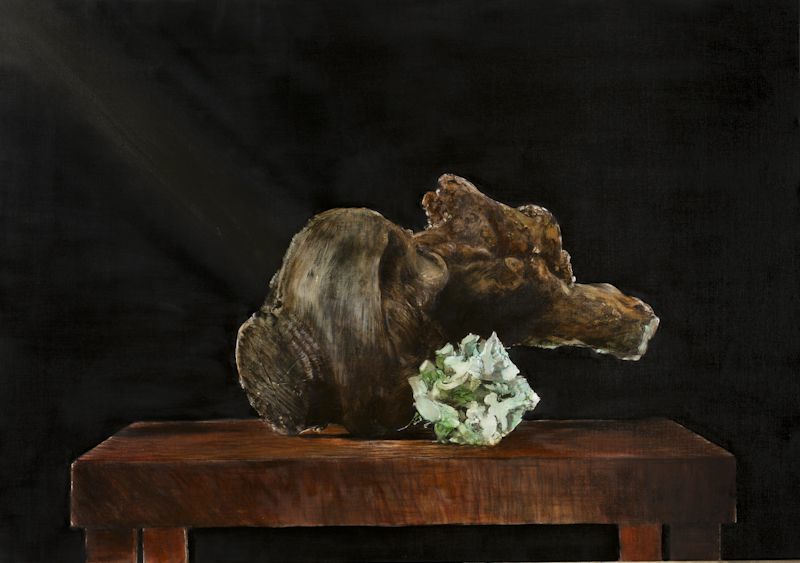
Geometrie 1 | 2012 | 70 x 100 cm | Öl auf Leinwand
There are artists who find nothing worse than people who try to explain art with their words. You wouldn't need to paint if you could just say what you wanted to say. The painting begins where language ends.
But there are people who persistently ask artists the question: What were you actually thinking with this picture, with this poem, with this composition? The poet Reiner Kunze once received the following letter about one of his poems:
Dear Mr Kunze,
For the elaboration of an interpretation of one of your poems, I would like to ask you for a statement. [...] We are addressing you directly because you are one of the few poets we have worked on who have not yet passed away, so it would be a unique opportunity for us to personally experience the author's intention. As we are pressed for time, please send us a prompt reply.
Postage for the reply is enclosed.
Thank you in advance.
Bremervörde, 18.09.861
The author published the letter together with the poem in question and the heading: "With return postage or the end of interpretation". Nothing more. No quote, no explanation. The arrangement of the texts itself became a subtle invitation by the poet to read his texts, if you please, without explanation.
Yes, there is a way of interpretation that kills texts - and images too! Because in talking intelligently about art, they prevent exactly what can happen - tonight and for all who visit this exhibition. That something specific, personal, individual happens when you stand in front of one of Bruno Griesel's paintings.
Bruno Griesel - the artist
I don't know what would happen if you asked Bruno Griesel himself this evening what he had in mind - with this or that work of art. He is here, the artist, in the midst of us, in the flesh, tangible, approachable, questionable. Bruno Griesel, born in Jena in 1960, was a student here in Markkleeberg from the age of eleven to 17, influenced by the Leipzig Academy of Visual Arts, especially by Professor Heisig, with whom he was a master student in the second half of the 1980s. Bruno Griesel, known throughout the world as a representative of the New Leipzig School (as controversial as this term is) - represented with exhibitions in New York, Shanghai, Salzburg - and of course many times in Germany and in our region: Köthen, Leipzig.
Bruno Griesel is delightfully and admirably relaxed when it comes to viewing his paintings. Yes, he has thought a lot about the masterpieces he shows us here at the White House. He has immersed himself in themes, dug deep historically and theoretically. The paintings are carefully conceived and crafted with the utmost precision, often over months.
But as much as all this is true, it is also possible to approach his pictures in a completely different way. To allow oneself to be directly addressed emotionally. After all, these pictures are 'beautiful' in the first place - and they are allowed to be. - Have you already seen how the blue skirt glows that the girl with the empty book in her hands is wearing? Have you already noticed the three red apples that can be seen in one of the pictures, lying on a table and shining in their red? Or the grain of the brown wooden table, which is encountered several times in these rooms? Or the reflection of this table and the sky in a jug standing on the table? Have you noticed the facial expressions of the people in the portraits?
Feelings are quick thoughts
If you look at these works and feel something, you already have an interpretation, admittedly a pre-verbal, non-verbal and yet true one. Bruno Griesel once said the beautiful sentence and wrote: "Feelings are quick thoughts." Yes, Bruno Griesel's pictures, however much the artist has 'thought' about them, may simply appeal emotionally. They may be liked. Or perceived as strange. They may trigger enthusiasm - or more or less mild horror. And, of course, astonishment.
Who knows what will appeal to you when you walk through the rooms?
Musical instruments, perhaps, painted in such a way that the sounds belonging to them are still hidden and yet can almost be heard ...
Or the interplay of white and black on one side and colours on the other: again and again: red, green, blue?
Who knows what appeals to you?
The city of Salzburg - seen here next door.
Or the letters that are repeatedly interspersed in the works and draw you into an interplay of text and colours, text and forms?
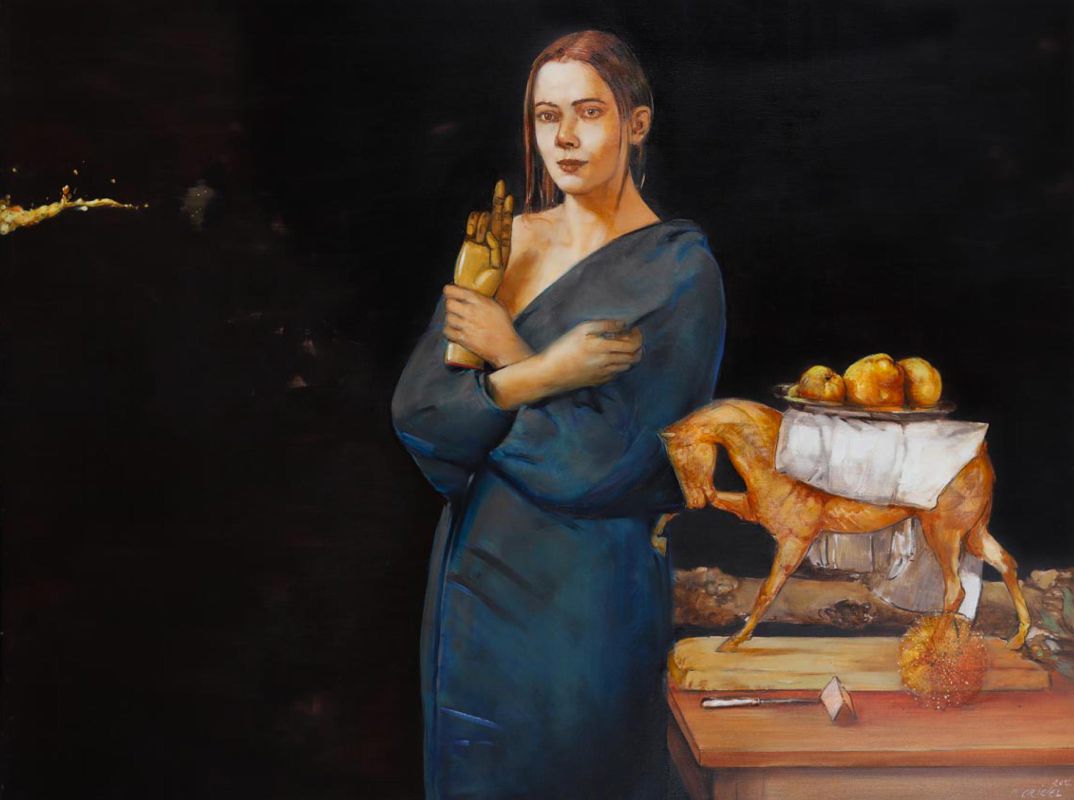
Gaudete | 2012 | 120 x 160 cm |Öl auf Leinwand

Die Tasse | 2012 | 70 x 100 cm | Öl auf Leinwand
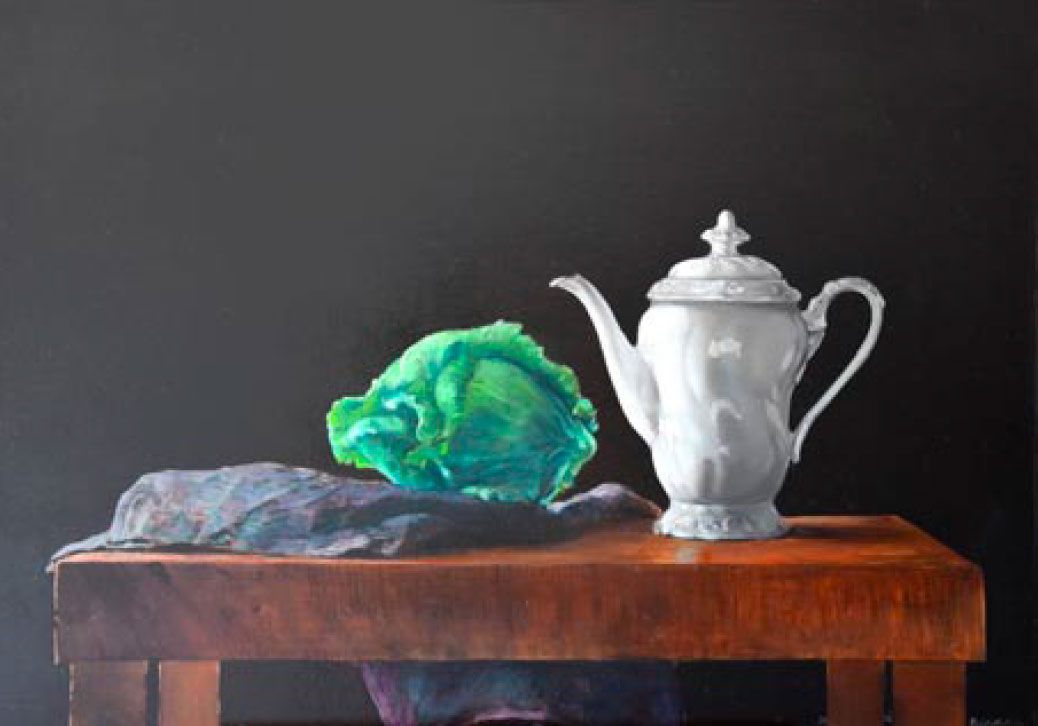
Die Kanne | 2012 | 70 x 100 cm | Öl auf Leinwand

Schrödingers Katze | 2012 | 160 x 200 cm |Öl auf Leinwand
Surface and deeper levels
It is worth taking a close look at the 28 pictures Bruno Griesel shows us in this exhibition. And then not only to perceive the surface, but to discover much more.
Music and painting
These paintings are about music - and for that reason alone, this exhibition fits wonderfully into this newly designed "White House". Especially here in the foyer, there are paintings that depict music. Bruno Griesel is an artist whose painting is in dialogue with other arts. "Flute and Colour Chord" is the name of the wonderful 2m by 1.50m painting created in 2015 that brings together the world of music and the world of painting. Red, green, blue - three colours as the basic chord of painting can be seen again and again: in rhombs, in the cloth, in the skirt of the young flutist. Three colours as a basic chord - corresponding to the three notes of musical chords. Three colours from which, according to the theory of additive colour/light mixing, everything is created (whereby the same intensity of the three results in white). Three tones from which the audible world always becomes new. And, strangely enough, three again and again ... Of course, the theologian is pleased - and yet he is also puzzled. What does Mephisto say in Goethe's Faust? "It has always been the way/ to spread error instead of truth through three and one, and one and three. - Or not error after all, as is shown anew in the interplay between music and painting?
Physics, mathematics and understanding the world
Yes, this exhibition is about music. But it is also about physics. Not actually about physics, which you usually learn at school, but about physics, which is much more philosophy and which hardly anyone really 'understands'. Bruno Griesel loves to take us to such limits of understanding with his painting. "Schrödinger's Cat", painted in 2012, is the name of one of Bruno Griesel's most famous recent paintings. In 1935, Erwin Schrödinger (I'm saying this in a very simplified way) realised how paradoxical it is when you try to transfer quantum mechanical concepts and theories to our world. It would then be possible, according to the rules of quantum mechanics, to bring a cat into a state in which it is both "alive" and "dead". Therefore, in Griesel's picture you see not only one cat, but two - but is this only a thought experiment of theoretical physics? Isn't this much more fundamentally the reality in which we live? Living and dead? "In the midst of life we are surrounded by death ...", as was already written in the Middle Ages and translated by Martin Luther? And is the one happy who knows this and lives with this insight - or the one who prefers to naively suppress it? Standing in front of the painting, you are led to exactly this border.
Yes, Griesel deals with the really big themes and questions. But not infrequently he also does it in a light way. "The Lemon Butterfly" is not far removed from "Schrödinger's Cat" and was written two years earlier. Griesel puts a play on words into the picture. Lemon butterfly - can lemons be folded? In the painter's two-dimensional world it is possible, sure; in the three-dimensional world we live in it would be unthinkable. The reality in which we are stuck and which we often consider so unchangeable is only one dimension. Let us jump with the painter into another one - and let us be shown the space in which lemons can be folded ...

Die Frage am Meer | 2013 | 100 x 120 cm | Öl auf Leinwand
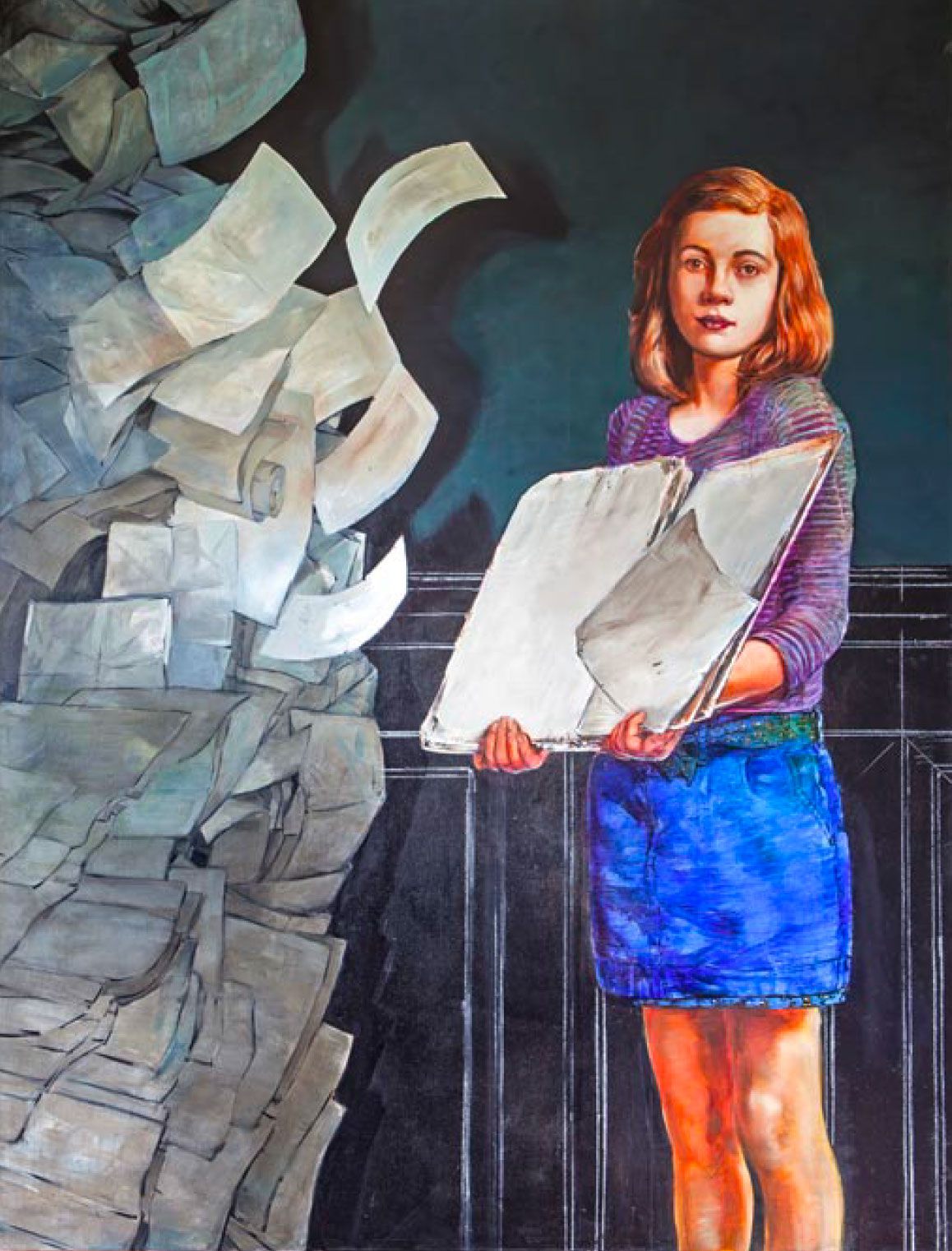
Sonate BWV 1003-1720 | 2013/14 | 200 x 150 cm | Öl auf Leinwand

Das Kleid | 2013/14 | 160 x 110 cm | Öl auf Leinwand
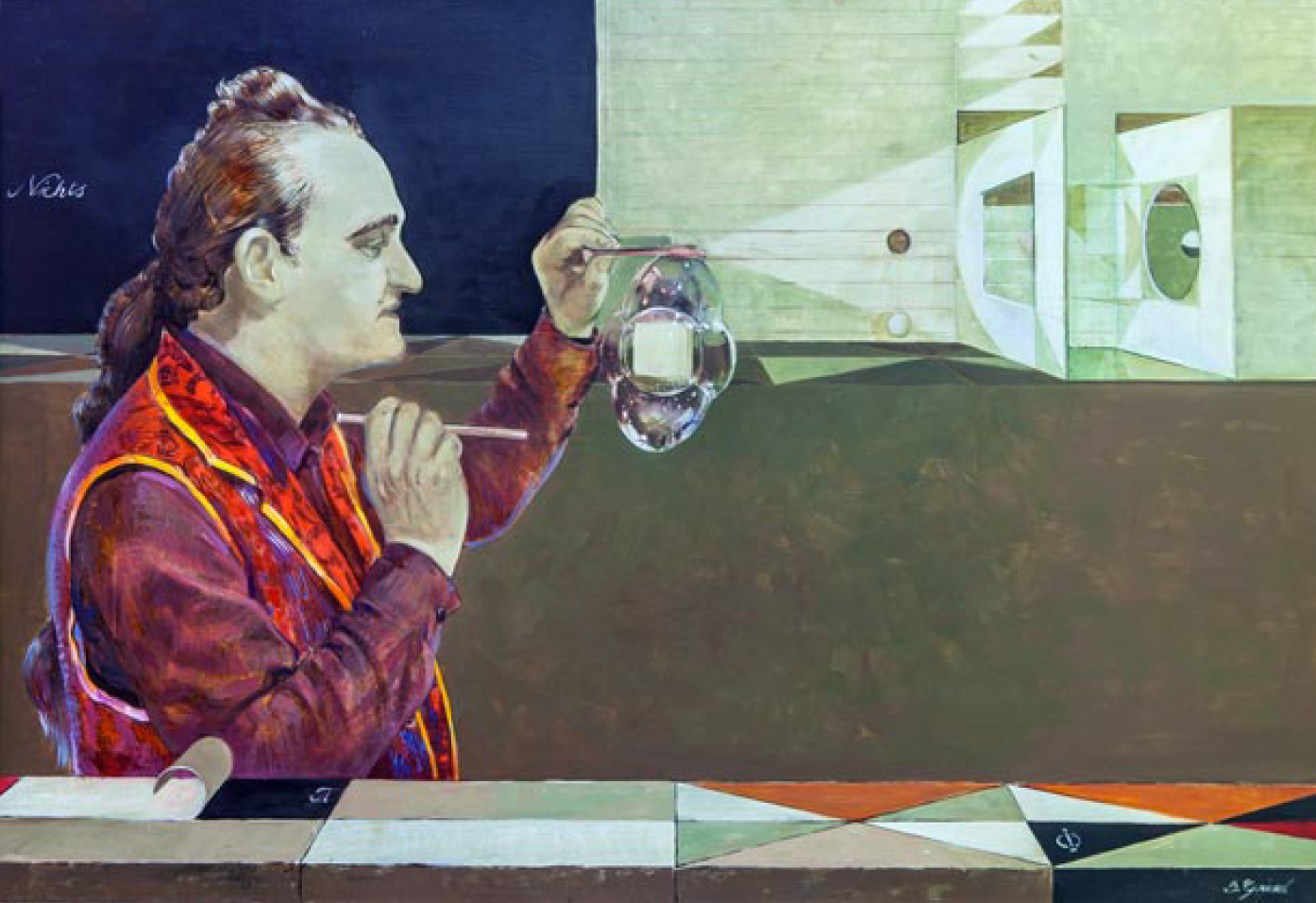
Die Lösung – Das E x periment | 2014 | 110 x 160 cm | Öl auf Leinwand
Light and colour
It is about music, it is about physics, it is about the arts and about the perception of our world. But again and again, and almost in all the paintings, it is about light and colour. How could it be otherwise - light and colour are the basis of the art of painting. Paul Klee once said: "Colour has me. I don't need to search for it. It has me forever. That is the meaning of the happy hour: I and the colour are one. I am a painter. "2
In a "white house" (and in a park that is white with snow tonight, and in an exhibition entitled WHITECUBE, white cube) Bruno Griesel lets us into the world of colour.
He once said of himself: "In my life I have noticed several colour periods ..." At first it was rather red for Griesel; since 1987 violet; 1990-1995: blue; until 1997: green; increasingly then the way to pure white. - White, the brightest of all colours, which for our perception always occurs when a material reflects the light in such a way that all three cones in the retina of the eye are stimulated in the same way. White - this is actually a mixture of individual colours and can be broken down into individual spectral colours with a prism (even if Goethe, unlike Newton, did not believe this at first and did not want to admit it). White - this is also a symbol of how the many becomes one and how diversity and unity belong together.
The colour "white" is not often found in the Bible - but it does appear in prominent moments. When Jesus was on a mountain with three of his disciples, his "garments" suddenly became "bright and very white, such as no bleacher on earth can make them so white" - and Jesus was transfigured before their eyes. He was drawn out of the Irish into the heavenly. A glow, a radiance that goes beyond this world and yet was seen in the midst of this world.
The artist Bruno Griesel is also a mystagogue - I hope you will allow me to call him that. One who takes us out of what we usually perceive and confronts us with riddles, with secrets. In the WHITECUBE, in the white cube, Bruno Griesel shows us what sounds and colours, texts and objects might be all about. Translated with www.DeepL.com/Translator (free version)
The way to the border
So this exhibition takes us to the limits - of our perception and even more so of our understanding. And I think Bruno Griesel takes great pleasure in seeing us right there.
Have you stood back there in front of the still life with the three red apples (yes, three again!) and a jug on a wooden table? And have you already read the title of this work: "The Question by the Sea"? But there is no sea ... Or is there?
Saint Augustine is said to have gone for a walk by the sea - at the time when he was working on his great work on the divine Trinity. And we are told how he observed a small child there. The child had dug a hole in the sand and now ran to the water again and again with a shell in his hand, scooped up with his shell, ran back and poured the water into the hole. Then he ran to the water again, scooped it up and repeated the whole thing over and over again.
After a while, Augustine asked, "What are you doing?" And the child answered him, "I am scooping the sea into this hole!" Augustine shook his head and said, "You little fool, that is impossible. You can't fill the great, wide sea into this hole!"
"But you imagine," said the child, looking piercingly at the great scholar, "that you can grasp the great mystery of the Trinity with your head?"
This is where Bruno Griesel takes us with his overwhelmingly beautiful and conceivably simple arrangement of three apples and a jug: to the very big questions and to the limits of understanding, where the mature and clever theologian looks old compared to the playful lightness of the child.
New perception in the newly designed white house
So why does one visit an exhibition? Perhaps because after visiting it, one perceives light in a new and different way.
And discover colours in a new way.
You hear music differently.
And see the world with different eyes.
Alexander Deeg
*2 Paul Klee, Tagebücher 1898–1918, hg. v. Felix Klee, Köln 1957,

